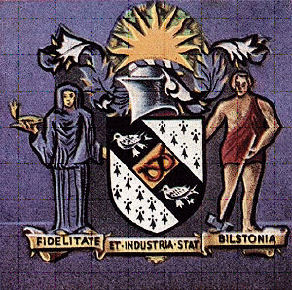 |
A History of BilstonPart 2 Pre Medieval Bilston |
|
"In Bilston there are two hides of land, which are four caracates and there are eight villeins and three borderers with three ploughs. Also an acre of meadow land. The wood is about a furlong long and a half broad. Was worth Twenty shillings, now thirty shillings".
In Doomsday Book there are the following references to the township of Bilston :-
"The same William ( Fitz Ansculfi ) holds in Ettingshall two hides, and Robert de Thurstan holds the of him by sac and soc. There are four caracates. In demesne are two acres, and nine villeins and three borderers with two ploughs. There are five acres of meadow, having a wood three furlongs in length and breadth. Valued and now of a value of thirty shillings".
" Walbertus holds of William( Fitz Ansculfi ) one hide in Bradley. There are II caracates, with them are four villeins having one plough. The wood is three furlongs long and one furlong broad. Valued and now of the value of sixty seven pence. Unlan holds by sac and soc. there are two acres of meadow land".
The population given is very small but it must be remembered that only the number of serfs is given.
Bilston remained in demesne until the reign of Henry III, when that King granted the lands belonging to the crown in Bilston to Walter de Bilston, for his valour at the battle of Evesham. In the reign of King John the King's tenant in Bilston was Simon Fitz Hubert, for in the great roll of that period there is this entry: "To Simon Fitz Hubert of Billestune the King oweth fifteen marks for six grey falcons: we therefore command that our Shrieve do pay the same out of the Exchequer".
Except for the few entries in public records, very little documentary evidence now remains to throw light upon the town from the twelfth to the fifteenth century.
The oldest preserved document next to the Doomsday Book is the Pipe Roll of the 31st year of Henry I. The earliest entry in these rolls relating to Bilston is the following for the years 1172-3:
"John de Dover and his fellow commissioners assessed a tax called an Assize of forty shillings upon the King's Demesne of Bilston" .
In the Plea Rolls of Henry III the following complaint was made:
"The men of the Lord the King of Bilestun complain that Juliana, the widow of Roger de Benetiega ( Bentley), and her son had erected buildings in the wood of the Lord the King at Benetlega, and destroyed the wood, where the aforesaid men were accustomed to Husbote and Heybote and other necessaries by the view of the Forester, and the said Juliana and her son did not permit them now to enter the said Wood". ( Husbote means faggots for the domestic hearth and Heybote, grass for Cattle)
This and other entries prove clearly enough that the district even up to the fourteenth century was still mostly covered with woods, the chief occupation of the population being swine and cattle feeding.
From a deed of surrender dated 1378 we learn that one Sir William Poort was appointed Parish Priest of Bilston, for in the deed Thomas Robyns and Juliana, his wife give to Sir William Poort ye Priest of Bilston and John Robyns jointly one messuage, one water mill etc..
In 1458 the chantry of St. Leonards was founded and members of the local gentry gave land for its upkeep, including "lands lying in a field called Windmill field in Bilston near the way lying from the said Bilston to Wolverhampton".
At the commencement of the reign of Richard II nearly the whole of the township remained unenclosed. Bradley was partially enclosed in 1479 when a deed which says that "all those meadows at ye bottom of ye New Lunt were taken and enclosed since Queen Mary�s time, and that when they all lay together unenclosed they went by ye name of Broad Meadow".
A document belonging to the early part of the fifteenth shows Bilston to have been inhabited by a few families of importance, their dependants and servants making at that time a population of something like 200 persons.